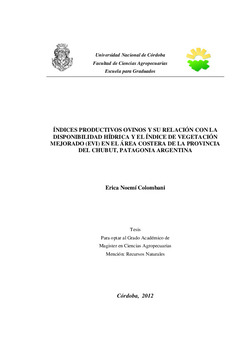| dc.contributor.advisor | Ovando, Gustavo Gabriel | |
| dc.contributor.author | Colombani, Erica Noemí | |
| dc.date.accessioned | 2014-11-13T18:54:09Z | |
| dc.date.available | 2014-11-13T18:54:09Z | |
| dc.date.issued | 2012 | |
| dc.identifier.uri | http://hdl.handle.net/11086/1615 | |
| dc.description | Tesis (Magister en Ciencias Agropecuarias. Mención: Recursos Naturales)--UNC- Facultad de Ciencias Agropecuarias, 2012. | es |
| dc.description.abstract | La predicción del tiempo en la escala de unas pocas semanas, pero principalmente del clima en la escala de meses y años, abriría importantes posibilidades en el manejo de la producción agropecuaria y permitiría la previsión de los períodos escasamente productivos de regiones específicas. El objetivo de este trabajo fue desarrollar y evaluar modelos predictivos basados en información de disponibilidad hídrica, carga animal e
índices de vegetación espectral, para estimar parámetros de la productividad ovina y
determinar prácticas de manejo en el área costera de la provincia del Chubut, Patagonia Argentina. Las precipitaciones medias anuales para el período 1995-2008 no difirieron
significativamente del promedio; se concentran en la época otoño-invernal, sin detectarse diferencias entre primavera y verano. Considerando el momento de ocurrencia de la lluvia durante el año, las de febrero tienen una influencia marcada en la
producción de lana por animal y por hectárea en la siguiente esquila. La inclusión de la carga animal mejoró considerablemente los resultados en los modelos explicativos de los índices productivos. Las precipitaciones y el índice de evapotranspiración (IE) del bimestre enero-febrero fueron las variables que mejor explicaron las variaciones en la producción de lana, mientras que las precipitaciones del bimestre marzo-abril constituyeron la mejor explicación del porcentaje de señalada. El diámetro de fibra fue mejor explicado por las precipitaciones del bimestre marzo-abril y por el IE del bimestre noviembre-diciembre. Cuando se analizó la correlación del índice de vegetación mejorado (EVI) con la disponibilidad hídrica se obtuvo una mejor relación a partir de IE que con la precipitación, por lo que este índice de sequía puede ser considerado un mejor estimador del EVI anual. Con respecto a los modelos para estimar los índices productivos a partir del EVI, los coeficientes de determinación obtenidos en
todos los casos fueron superiores a los modelos que utilizan la precipitación o el IE. De
acuerdo a estos resultados, el índice de vegetación EVI de MODIS, en razón que permite analizar mayor información ambiental, es un mejor indicador que la precipitación y el IE para estimar la productividad ovina en el área de estudio. | es |
| dc.description.abstract | The weather forecast in the scale of a few weeks, but mainly the climate in the scale of months and years, would open important possibilities in the management of the agricultural production and would allow the anticipated forecast of the scarcely
productive periods in specific regions. The objective of this work was to develop and to evaluate predictive models based on information of water availability, stocking rate and spectral vegetation indices, to estimate parameters of sheep productivity and to determine management practices in the coastal area of Chubut province, Argentinean
Patagonia. The average annual rainfall for the period 1995-2008 did not differ significantly from the average; they are concentrated in the autumn-winter season
without detection differences between spring and summer. Considering the moment of occurrence of the rainfall within the year, the rain of February has an important influence in the wool production per animal and per hectare in the following shearing.
The inclusion of the stocking rate considerably improved the results in the explanatory models of the productive indices. The rainfall and the evapotranspiration index (IE) of the January-February bimester were those that better explained the variations in wool production, while the rainfall in the bimester March-April were the best explanation for the percentage of livestock marking. The fiber diameter was better explained by the rainfall in the March-April bimester and by the IE of the bimester November-December. When the correlation of the enhanced vegetation index (EVI) with the IE was analyzed,
a better relation based on the IE than with rainfall was obtained, therefore this one drought index can be considered a better estimator of the annual EVI. With regard the models for estimating the productive indices based on EVI, the determination
coefficients obtained in all cases were higher than those of models utilizing precipitations and IE. Based on these results, the vegetation index EVI of MODIS, in
reason that allows to analyze more environmental information, is a better indicator than
the precipitation and IE to estimate sheep productivity in the study area. | en |
| dc.format.extent | 151 h. : il. col. | |
| dc.language.iso | spa | es |
| dc.rights | Atribución-NoComercial-SinDerivadas 2.5 Argentina | * |
| dc.rights.uri | http://creativecommons.org/licenses/by-nc-nd/2.5/ar/ | * |
| dc.subject | Ovinos | es |
| dc.subject | Producción de lana | es |
| dc.subject | Disponibilidad del agua | es |
| dc.subject | Carga ganadera | es |
| dc.subject | Chubut | es |
| dc.subject | Argentina | es |
| dc.title | Indices productivos ovinos y su relación con la disponibilidad hídrica y el índice de vegetación mejorado (EVI) en el área costera de la provincia del Chubut, Patagonia Argentina | es |
| dc.type | masterThesis | es |





